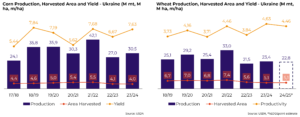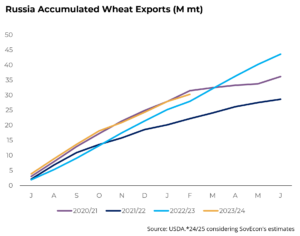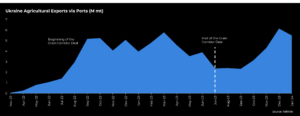Ukraine and the commodities market impact 2 years after the conflict started
Conflict in Ukraine – 2 years later: find out what the impacts have been on the commodities market and what the outlook is for 2024.
It’s been 2 years since the conflict in Ukraine began in February 2022. Russia’s invasion of Ukrainian territory has had significant consequences for the commodities market.
Among the consequences were significant changes in the global trade flow of various agricultural products. The world experienced a supply disruption immediately after the invasion: the European Union had to establish alternative land transportation routes in the Black Sea.

In this exclusive content, we give you the whole picture two years after the conflict. We highlight the most important points from our webinar “Ukraine conflict and commodity markets: two years later“, presented by Chris Trant, Head of Agriculture at hEDGEpoint in the United States.
Keep reading!
Ukraine: impacts of the conflict on the country’s agriculture
The conflict in Ukraine has had major impacts on the country’s agriculture. Among them, we highlight the following data obtained from a survey by the FAO (Food and Agriculture Organization of the United Nations):
- Smaller production area: at the local level, farmers reported a 9% decrease in the size of the area under cultivation for grains and oilseeds compared to the pre-conflict period.
- Increase in production costs: 93% of companies involved in agricultural production reported an increase in costs.
- Unexploded bombs: approximately 12% of farmers reported that part of their land is potentially contaminated by unexploded ordnance.
- Changes in agricultural decisions: almost 40% of all farmers pointed to changes in their agricultural operational decisions due to the conflict. One of the main measures is the limited use of agricultural inputs such as seeds, pesticides and fertilizers.
However, in recent seasons, favorable weather has mitigated the negative effects of the conflict on the country’s production and contributed to good yields. Two other movements were also important in this recovery:
- The largest volume is exported via the Danube River ports + the Romanian port of Constanta.
- Efforts by the Ukrainian navy to secure the flow through Odessa.

Leia mais:
- Conflito na Ucrânia: os principais impactos no mercado de commodities
Russia: leading the world in wheat production
With the conflict, Western sanctions affected the Russian economy. As a result, the country achieved smaller trade surpluses. In general, Russia’s agricultural exports were not significantly impacted by the conflict.
The country’s record production has led to very high levels of wheat exports. Russia also has an advantage in continuing to export its wheat at cheap prices: most of its main importers are geopolitical allies, such as Egypt and Turkey.

Commodity trade flows in the Black Sea: what has changed so far?
Despite all the challenges posed by the two-year conflict, the Black Sea’s share of total global grain and oilseed exports has increased.
Regarding prices, even with logistical challenges, Ukraine’s FOB value is one of the lowest in the world. At the same time, the large production of Russian wheat has remained extremely competitive in the market.
With the passage of grain through the Black Sea, Ukraine has been able to export more. But recently, the country has surpassed the figures obtained during the period when the Grain Corridor was in force.

Despite the initial strong shock to supply and prices, the global commodities markets have rebalanced. Trade routes, previously unthinkable, have become a reality.
● Outlook for 2024
Two years after the conflict, exports via the Black Sea have become increasingly important. Of the 8.1 billion people on the planet, 2.5 billion depend on wheat from the Black Sea.
However, due to the reduction in corn exports from Ukraine, the role of the Black Sea is likely to diminish this year. With lower imports from China, which currently imports the commodity mainly from Brazil and the United States.
The world wheat stock/consumption ratio is the tightest since 13/14. Almost all the main producing countries had smaller harvests compared to the previous year, which caused a tight global balance.
In the coming months, trade flows will continue to be in the spotlight around the world, as the wheat harvest in the region begins at the start of the second half of the year. However, there are some indicators of another large harvest in Russia, with favorable weather.
Ukraine, meanwhile, is expected to have another harvest slightly above the 20-million-ton mark in terms of production.
Read also:
- General outlook for agricultural and energy commodities in 2024
Conflict in Ukraine: review the main events that marked the market
To help you understand the main events triggered by the conflict in Ukraine, we’ve put together a timeline below. Check it out!

hEDGEpoint HUB: market intelligence to manage risks
As you can see, the commodities market is volatile. Subject to fluctuations in supply and demand triggered by issues such as geopolitical conflicts, risk management is essential.
By using sophisticated hedging products, players in this sector can protect themselves from volatility. At hEDGEpoint, we combine market intelligence, with up-to-date reports, with hedging tools that help the entire agricultural and energy commodities chain.
To this end, we offer hEDGEpoint HUB, our educational platform adapted to different levels of knowledge. With a global team, we deeply analyze all the aspects that can influence the commodities market.
Subscribe to the hEDGEpoint HUB and get exclusive access to our content!






